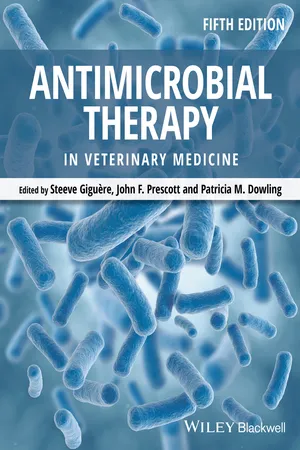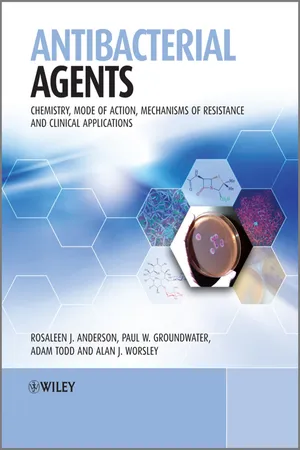Biological Sciences
Sulfa Drugs
Sulfa drugs, also known as sulfonamides, are a class of synthetic antibiotics that inhibit the growth of bacteria by interfering with the synthesis of folic acid, a key component for bacterial growth. They were the first effective treatment for bacterial infections and played a significant role in reducing mortality rates from infectious diseases. However, their use has declined due to the development of antibiotic resistance and the availability of more effective antibiotics.
Written by Perlego with AI-assistance
Related key terms
4 Key excerpts on "Sulfa Drugs"
- eBook - ePub
- Rene Krata(Author)
- 2011(Publication Date)
- Barrons Educational Series(Publisher)
Table 23.2 .REMEMBERAntibiotics work by stopping bacteria from performing essential cell functions like cell wall synthesis and protein synthesis.FIGURE 23.1. Mechanisms of action of antibacterial drugs.INHIBITION OF ENZYME ACTIVITYThe Sulfa Drugs , or sulfonamides , were the first synthetic agents to be widely used against bacterial infections. They inhibit bacterial growth by interfering with an important metabolic pathway that synthesizes folic acid. For example, sulfanilamide is very similar in structure to para-aminobenzoic acid (PABA), a precursor to folic acid (Figure 23.2 ). If sulfanilamide is present in a bacterial cell, it inhibits the activity of an enzyme in the pathway that synthesizes folic acid. It does this by mimicking PABA and slipping into the active site of the enzyme, blocking PABA from entering. The bacterium cannot synthesize enough folic acid, which it needs for the synthesis of DNA. The host is not affected because humans get their folic acid from their food and do not need to make their own.TABLE 23.2. Some Commonly Used Antibiotics Organized by Chemical StructureFIGURE 23.2. Comparison of PABA and sulfanilamide.The enzyme inhibitor sulfanilamide is so similar in structure to PABA that it can fit into the active site of the enzyme that uses PABA as a substrate in folic acid synthesis.INHIBITION OF CELL WALL SYNTHESISBecause human cells do not make peptidoglycan, drugs that inhibit its formation are highly selective. This includes the penicillins , which block formation of the peptide cross-links that stabilize peptidoglycan structure (Chapter 4 ). The penicillins are a large group of antibiotics that all have a common structure called the beta-lactam ring (Figure 23.3 ), which is essential to the function of the penicillins. There are two main categories of penicillins: natural penicillins that are produced directly by fungi and semisynthetic penicillins that are chemically modified from natural penicillins (Figure 23.3 - eBook - ePub
- Steeve Giguère, John F. Prescott, Patricia M. Dowling(Authors)
- 2013(Publication Date)
- Wiley-Blackwell(Publisher)
Section IGeneral Principles of Antimicrobial Therapy
Passage contains an image
1
Antimicrobial Drug Action and Interaction: An Introduction
Steeve GiguèreAntimicrobial drugs exploit differences in structure or biochemical function between host and parasite. Modern chemotherapy is traced to Paul Ehrlich, a pupil of Robert Koch, who devoted his career to discovering agents that possessed selective toxicity so that they might act as so-called “magic bullets” in the fight against infectious diseases. The remarkable efficacy of modern antimicrobial drugs still retains a sense of the miraculous. Sulfonamides, the first clinically successful broad-spectrum antibacterial agents, were produced in Germany in 1935.However, it was the discovery of the antibiotic penicillin, a fungal metabolite, by Fleming in 1929, and its subsequent development by Chain and Florey during World War II, that led to the antibiotic revolution. Within a few years of the introduction of penicillin, many other antibiotics were described. This was followed by the development of semisynthetic and synthetic (e.g., sulfonamides and fluoroquinolones) antimicrobial agents, which has resulted in an increasingly powerful and effective array of compounds used to treat infectious diseases. In relation to this, the term antibiotic has been defined as a low molecular weight substance produced by a microorganism that at low concentrations inhibits or kills other microorganisms. In contrast, the word antimicrobial has a broader definition than antibiotic and includes any substance of natural, semisynthetic, or synthetic origin that kills or inhibits the growth of a microorganism but causes little or no damage to the host. In many instances, antimicrobial agent is used synonymously with antibiotic - eBook - ePub
Antibacterial Agents
Chemistry, Mode of Action, Mechanisms of Resistance and Clinical Applications
- Rosaleen Anderson, Paul W. Groundwater, Adam Todd, Alan Worsley(Authors)
- 2012(Publication Date)
- Wiley(Publisher)
In essence, sulfonamides with a pK a2 close to 5–7 are better accumulated in bacteria, since they predominantly exist in the unionised (neutral) form outside the cell, and can pass through the bacterial membrane by passive diffusion, then become partly ionised inside the bacterial cells, due to the slightly higher pH (usually around 7.6), leaving them trapped. Sulfonamides with a higher pK a2 value are ionised to a lesser extent in bacterial cells, as this would require more basic conditions than the intracellular pH provides; these sulfonamides can freely diffuse into and out of the cell, preventing their accumulation. 3.1.4 Mode of Action and Selectivity During the early antibacterial studies, it was discovered that the sulfonamides (then referred to as sulphonamides, sulpha, or Sulfa Drugs) were bacteriostatic, as they prevented the growth of bacteria, but did not kill them, and that, when para -aminobenzoic acid (PABA) was added to bacterial culture at the same time as sulfonamide, the drug had little or no effect. As we learned in Subsection 1.1.3.2, bacteria require PABA (an essential metabolite) for the synthesis of folic acid and lack the protein required for folate uptake from their environment. Folic acid is an essential metabolite for mammals as it cannot be synthesised by mammalian cells and must be obtained from the mammalian diet (you can check how much folic acid you require daily by reading the ingredients on the side of your breakfast cereal packet) - eBook - ePub
Chemistry and Medicines
An Introductory Text
- James R Hanson(Author)
- 2006(Publication Date)
- Royal Society of Chemistry(Publisher)
1 unit to uracil to form thymidine, a major component of the nucleic acids. In humans, folic acid is an essential dietary factor which is obtained from food. It is not biosynthesized by man. Consequently, the sulfonamides have no direct effect on folic acid in man but only on the production of folic acid in bacteria.The conversion of dihydrofolic acid 6.22 to tetrahydrofolic acid 6.24 is inhibited by another anti-bacterial agent, trimethoprim 6.23. A combination therapy of sulfamethoxazole 6.19 and trimethoprim (co-trimazole) has been particularly useful in combating resistance. If a bacterium develops resistance to sulfamethoxazole, it is killed by trimethoprim before it can replicate and so the resistance cannot be passed on. The enzyme dihydrofolate reductase has been crystallized and its X-ray crystal structure has been determined. The structure of the enzyme containing bound trimethoprim has also been determined.6.6 THE PENICILLINS
The observation by Fleming in 1928 of the antibiosis by the fungus Penicillium notatum , a chance contaminant of a culture of a Staphylococcus species proved to be one of the major discoveries of medicinal chemistry. The isolation of the penicillin antibiotics and the determination of their structure required a major microbiological and chemical effort in the days before spectroscopy played a major role in structure elucidation.The fungus Penicillium notatum produced a mixture of related compounds that were not particularly stable and which possessed what at that time, was an unknown ring system 6.25. The work was facilitated by the discovery in the USA of a higher-yielding strain of another fungus, Penicillium chrysogenum . The penicillins were shown to possess a common core and to differ from each other in the nature of the side chain. Their valuable antibiotic properties were demonstrated in the early years of the Second World War with a number of trials being conducted in 1941. These trials provided the stimulus for the major effort required to study the chemistry of the penicillins. Their structure was solved in 1945 by a combination of chemical and X-ray crystallographic work. A significant further advance came in 1959 with the development of enzymatic methods for isolating the core of the penicillins, 6-aminopenicillanic acid 6.28 from the major fermentation products, penicillins G 6.26 and V 6.27.
Learn about this page
Index pages curate the most relevant extracts from our library of academic textbooks. They’ve been created using an in-house natural language model (NLM), each adding context and meaning to key research topics.



